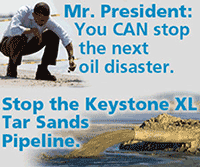
Now its Yellowstone To Keystone
 You would have thought that Rupert Murdoch had enough on his plate right now without one of his paper’s backing the highly controversial Keystone XL tar sands pipeline in an editorial yesterday.
You would have thought that Rupert Murdoch had enough on his plate right now without one of his paper’s backing the highly controversial Keystone XL tar sands pipeline in an editorial yesterday.
Despite the deep controversy surrounding the specific project and the safety of pipelines in general, which have been reigntied by Exxon’s Yellowstone spill, the Wall Street Journal argues that Keystone is “hardly a radical proposal.”
In an editorial that looks like it was penned in the boardrooms of Houston, the paper argues that “If Mr. Obama were drawing up a plan from scratch to boost union employment and deflate Iranian-ally Hugo Chávez of Venezuela, it might look like the Keystone XL.”
It waxes lyrical about the amount of jobs that TransCanada estimates will be created, some 13,000 direct and 118,000 “Spin-off” ones during the construction. Moreover the pipeline would “not significantly affect the environment” and without it the U.S. “would remain dependent upon unstable foreign oil supplies.”
Seems a no-brainer to the Murdoch boys at the Journal. The paper then goes onto arguing that pipeline safety may be a reason for the delay, but that “pipelines remain the statistically safest way to transport oil”, before adding that the spill at Yellowstone was “unfortunate”.
The real reason for the delay, argues the paper is that “the tar sands has become the next Alaska in green mythology.”
The oil boys north of the border are ecstatic about Murdoch’s intervention. TransCanada’s president and CEO Russ Girling said yesterday that “the benefits are clear to us and anyone who read the Wall Street Journal article this morning will see some other people are starting to get that as well.“
Well not everyone. The NRDC responded yesterday saying the “editorial’s support for the pipeline is based on a mirage, not on true jobs or energy security. And it barely touches on the darker side of tar sands oil: increased global warming pollution, oil spills and Boreal forest destruction.”
The blog argued what most people in the oil industry cannot fathom that “The best plan for America to achieve jobs and energy security is through investment in clean energy. Only clean energy will give us the homegrown, long-term economic prosperity, environmental safety and energy security that we need.”
And talking about environmental safety it is worth pointing out how the WSJ just skipped over Exxon’s recent Yellowstone spill, which is further evidence that transporting oil over large areas always brings risks, especially in ecologically sensitive areas.
And the worrying thing, as the New York Times points out is that Keystone XL would cross the same river as the recent spill.
Its amazing that the US authorities would put another pipeline in the same area. As the paper points out, the spill “has renewed calls for nationwide action.”
Sen. Frank Lautenberg (D-N.J.), a chief sponsor of broader pipeline safety legislation, argues that the Yellowstone incident “reminds us of the precarious nature of these pipelines. To stand by and not protect those who are nearby … is not right.”
And there are many people who argue because of the climatic risks of the tar sands, building Keystone XL would not “be right” either.
Not forgetting the risks to the Yellowstone.
